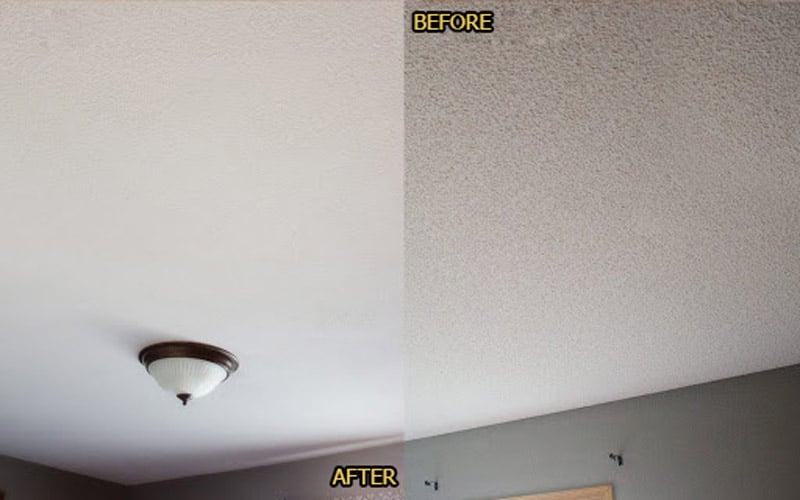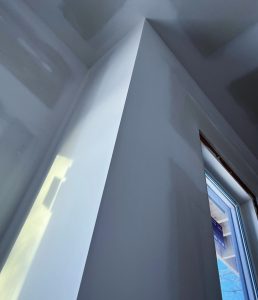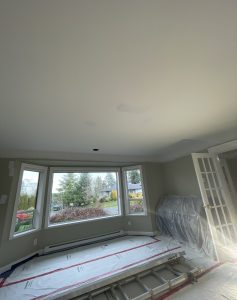When considering whether to remove textured ceilings through skimming or boarding, it’s essential to delve into the nuances of each method to make an informed decision. Textured ceilings, often popular in older homes, can become outdated or worn over time, prompting homeowners to seek ways to modernize their space. Both skimming and boarding offer solutions to transform textured ceilings into smooth, contemporary surfaces, but they vary in terms of cost, time, durability, and suitability for different types of ceilings.
Skimming:
Skimming involves applying a thin layer of plaster over the existing textured ceiling to create a smooth finish. This method is preferred for minor imperfections or when the existing ceiling is in relatively good condition. Here’s a more detailed look at the pros and cons of skimming:
Pros:
Cost-effectiveness: Skimming is often more budget-friendly compared to boarding because it requires fewer materials and less labor. Homeowners looking for a cost-effective way to update their ceilings may find skimming to be an appealing option.
Speed: Skimming is generally faster than boarding, particularly for smaller areas. The process involves preparing the existing ceiling surface and applying the plaster layer, which can be completed relatively quickly compared to installing plasterboard.
Minimal disruption: Since skimming involves working with the existing ceiling surface rather than removing it entirely, there is typically less disruption to the home during the process. Homeowners can expect minimal mess and inconvenience compared to more extensive renovation projects.
Cons:
Limited suitability for severe damage: While skimming can effectively conceal minor imperfections, it may not be suitable for ceilings with significant damage or structural issues. In cases where the existing ceiling requires extensive repairs, skimming alone may not provide a satisfactory result.
Potential for less durability: Skimmed ceilings may be more prone to cracking over time compared to boarded ceilings, especially if the underlying structure or substrate is not stable. While skilled craftsmanship can mitigate this risk, homeowners should be aware of the potential for future maintenance issues.
Boarding:
Boarding involves installing new plasterboard over the existing textured ceiling before applying a finishing layer of plaster. This method is preferred for ceilings with more significant damage or imperfections, as it provides a fresh surface for renovation. Here’s a closer look at the pros and cons of boarding:
Pros:
Suitability for damaged ceilings: Boarding is an excellent option for ceilings with extensive damage, such as cracks, water stains, or uneven surfaces. By installing new plasterboard, homeowners can create a smooth and stable base for finishing, effectively concealing imperfections.
Enhanced durability: Plasterboard provides a more durable and stable surface compared to skimmed ceilings, reducing the risk of cracking or other issues over time. Homeowners can expect a longer-lasting result with proper installation and maintenance.
Versatility in material selection: Boarding offers flexibility in choosing different types and thicknesses of plasterboard to suit specific requirements. Whether seeking enhanced soundproofing, fire resistance, or other properties, homeowners can select the appropriate plasterboard for their needs.
Cons:
Higher cost: Boarding tends to be more expensive than skimming due to the additional materials and labor involved. The cost of purchasing and installing plasterboard, along with the necessary finishing materials, can contribute to a higher overall project cost.
Extended timeline: Boarding requires more time to complete compared to skimming, as it involves installing plasterboard before applying the finishing layer of plaster. Homeowners should expect a longer renovation timeline when opting for this method, particularly for larger or more complex ceiling surfaces.
Ultimately, the choice between skimming and boarding depends on factors such as the condition of the existing ceiling, budget, timeline, and desired outcome. While skimming offers a cost-effective and relatively quick solution for minor imperfections, boarding provides a more durable and versatile option for ceilings with significant damage or structural issues. Homeowners should carefully assess their priorities and consult with experienced professionals to determine the best approach for their textured ceiling removal project.
Considerations for Textured Ceiling Removal:
Before proceeding with textured ceiling removal, homeowners should consider several factors to ensure a successful renovation project:
Assessment of existing ceiling: Prior to selecting a removal method, it’s essential to assess the condition of the existing textured ceiling. Determine the extent of any damage, structural issues, or imperfections that may impact the renovation process.
Budget and cost estimates: Establish a realistic budget for the removal and renovation of the textured ceiling, taking into account materials, labor, and any additional expenses. Compare the costs of skimming versus boarding to determine the most cost-effective option for your project.
Timeline and project duration: Consider the time required to complete the removal and renovation process, including preparation, installation, and finishing. Factor in any potential disruptions to daily life and plan accordingly to minimize inconvenience.
Professional expertise: Seek guidance from experienced professionals, such as contractors or plasterers, who can provide valuable insight and recommendations based on their expertise. A skilled contractor can assess the condition of the existing ceiling, recommend the most suitable removal method, and ensure high-quality workmanship throughout the renovation process.
Future maintenance considerations: Keep in mind the long-term maintenance requirements of the renovated ceiling, particularly in terms of durability and potential for wear and tear. Choose a removal method that offers a sustainable and durable solution to minimize the need for future repairs or maintenance.
By carefully considering these factors and weighing the pros and cons of skimming versus boarding, homeowners can make an informed decision that aligns with their goals, budget, and timeline for textured ceiling removal. Whether seeking a cost-effective solution for minor imperfections or a more durable option for significant damage, the right approach can transform a textured ceiling into a smooth, modern surface that enhances the overall look and feel of the space.






